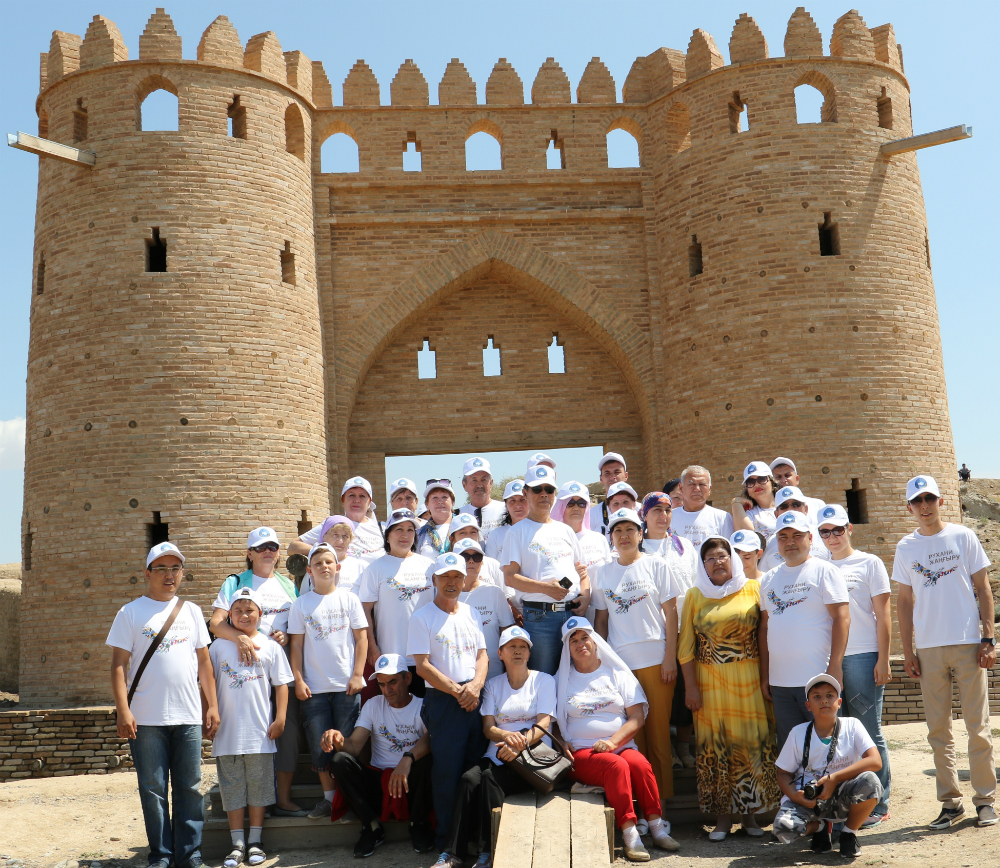
08 August, 2017

Historical and educational expedition «Yli Dala Eli»
To familiarize with the precious historical and cultural heritage of the country, the Kyzylorda regional assembly of the people of Kazakhstan organized a trip to the ancient cities of Kyzylorda and South Kazakhstan regions.
The group included the head of the secretariat of the regional assembly of the people of Kazakhstan, Lyalya Tureshova, the director of the Kokhumi kelishim Ualikhan Ibraev, the deputy director Rahim Akhmetov, the leaders and members of the ethno-cultural associations, the members of the scientific expert group, the club of journalists and experts and the youth wing.
According to the head of the Secretariat of the Assembly of the People of Kazakhstan L. Tureshova, "The purpose of the historical and cognitive expedition is to get acquainted with the history of the medieval cities of Otrar, Sauran, Syganak, as well as archeological complexes of Arystanbaba and Khoja Ahmet Yasavi through a tour of the historical and cultural heritage of South Kazakhstan and Kyzylorda Regions within the framework of the "Tu-an-zher" program, identified in the article of the President "A glance at the future: modernization of public consciousness". Strengthening the identity of Kazakhstanis, national unity on the basis of propaganda and study of the spiritual values of the people of Kazakhstan. In the future, it is planned to show representatives of ethnoses other monuments of history and culture of the region, through them to raise the knowledge of diasporas about the history and rich spiritual values of their native land, to strengthen the patriotic feelings of the people of Kazakhstan. "
Members of the expedition, consisting of 50 people, first of all visited the ancient city of our ancestors Turkestan located between the mountains of Karatau and the Syrdarya river, along the Great Silk Road. There, on the land of ancient Otrar, they stopped at the monument of architecture - the mausoleum of Arystanbaba. Members of the expedition visited the mausoleum of Arystanbaba, who traveled all over the world, studied various religious currents, and after the adoption of Islam, spent the rest of his life preaching Islam of the Sufi type. They got a lot of information about Arystanbag, who lived for 400 years and was an associate of the Prophet Muhammad.
After that, members of the expedition visited one of the largest and most developed cities - the Otrar fortress. Otrar Oasis is located in the modern Otrar area of the South Kazakhstan region, in the 57th kilometer south of the city of Turkestan, near the place where the Arys River flows into the Syr Darya. The hillfort is a ruin of the ancient city of Otrar, also known in history as Farab - the center of medieval trade.
Director of KSU "Kokamdyk kelіsim", candidate of historical sciences U. Ibraev said: "From the historical point of view, our region is the richest place. Just on this land are the places of residence of the most ancient people in the territory of Kazakhstan. Here lived the great scientists of their era. It was in this city that a great philosopher and mathematician, named "the second teacher" after Aristotle, Abu Nasir Al-Farabi, was born. "
The expedition continued its work on a grandiose architectural monument, a vivid example of medieval architecture - the mausoleum of Khoja Ahmet Yasawi. This is the first construction in Kazakhstan, included in the UNESCO World Heritage List. He is in the city of Turkestan in the South Kazakhstan region. The mausoleum was erected in honor of the founder of Sufism, thinker, poet, preacher Khoja Ahmet Khazreti Sultan Yassavi. Yasavi studied with Arystanbaba and Yusuf Hamadani, studied the basics of Sufism, Arabic, Chagatai and Persian languages, poetry and literature of the East. In his teaching he preached asceticism, patience, kindness, justice and honesty. 233 years after the death of Yassavi, a new mausoleum was built by the order of the all-powerful ruler of Central Asia, Emir Timur. The mosque of Khoja Ahmet Yassawi became a place of mass pilgrimage for Muslims around the world. Here, representatives of ethnic groups got acquainted with historical documents and exhibits describing the life of Khoja Ahmet Yasawi. Attentively listening to the guide, tried to get rich information.
Further, the members of the expedition kept a course at the historic-ethnographic museum located in the city of Turkestan, as well as the ethnocentre, considered a treasure trove of the heritage of the Kazakh people and spiritual wealth. There they got acquainted with the history and spiritual life of Turkestan through a collection of historical relics from the fund of the center. The museum exposition of the center is located at 3800 square meters. The building consists of 3 floors, 5 exhibition halls, a conference hall, a craft workshop and rooms for research works of historians.
The historical-cognitive expedition visited the Sauran site, situated 40 kilometers west of the city of Turkestan on the border with the South Kazakhstan region. In the middle of the 13th century, Sauran was the capital of the Ak Orda. At the end of the 14th century, Emir Timur turned the city into a military fortress. Now there are ruins of the walls and minarets of Sauran, a rounded area measuring 500-880 m. Members of the expedition entered the city through the gates and saw traces of canals from the outside of the defensive fence of the city, observed traces of seven rows of protective walls.
The final stop of the historical and educational expedition "Eli Dala Eli" was a unique cultural and historical monument of the Kyzylorda region - an ancient city with a history of two thousand years, the former capital of the Kipchak Khanate, Ak Orda, the Khanate of Abulkhair, and then the Kazakh Khanate - Syganak. The city of Syganak is located 2 kilometers to the north-west of the present settlement "Sunakata" on a pentagonal hill, on the territory of 20 hectares. Life in the city continued from the VI century to the XVIII century. During the Mongol invasion the city was completely destroyed, and only since the XIV century, the newly rebuilt city of Syganak became the capital of the state of Ak Orda.
During the expedition its participants, expressing their gratitude to the organizers, shared their impressions, left their wishes in the books of the reviews.
Дата события ассамблеи: 08.08.2017
Похожие новости
-
8th of March is a holiday of beauty, kindness and charm
-
A President: The solicitude, unshakable unity and solidarity of our people are widely celebrated on this day
-
Assembly of People of Kazakhstan: 27 thousand ethnic groups have participated at the event dedicated to Abai`s Day
-
Happy Defender of Fatherland Day!
-
Address by the Assembly of People of Kazakhstan: The World is Changing in Noticeable Way
-
Grandmother and her grandson sew masks and give them free of charge
Похожие новости
-
8th of March is a holiday of beauty, kindness and charm
-
A President: The solicitude, unshakable unity and solidarity of our people are widely celebrated on this day
-
Assembly of People of Kazakhstan: 27 thousand ethnic groups have participated at the event dedicated to Abai`s Day
-
Happy Defender of Fatherland Day!
-
Address by the Assembly of People of Kazakhstan: The World is Changing in Noticeable Way
-
Grandmother and her grandson sew masks and give them free of charge






